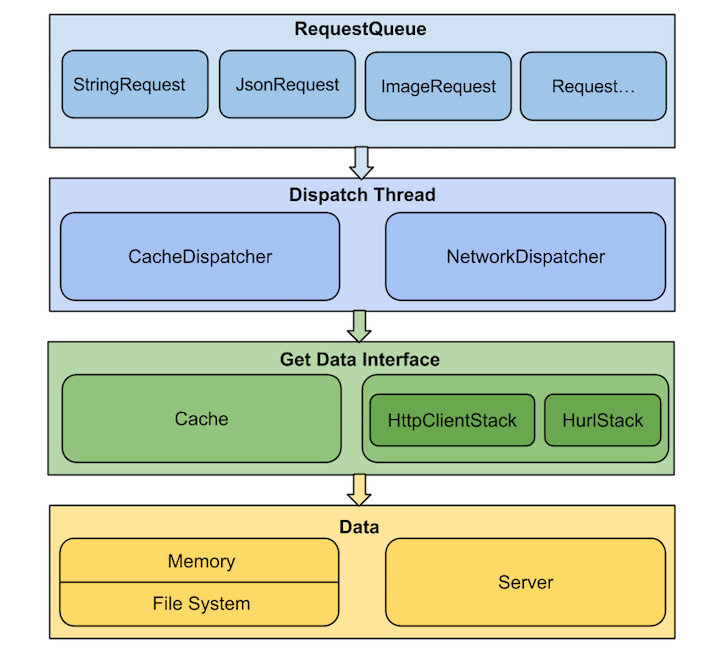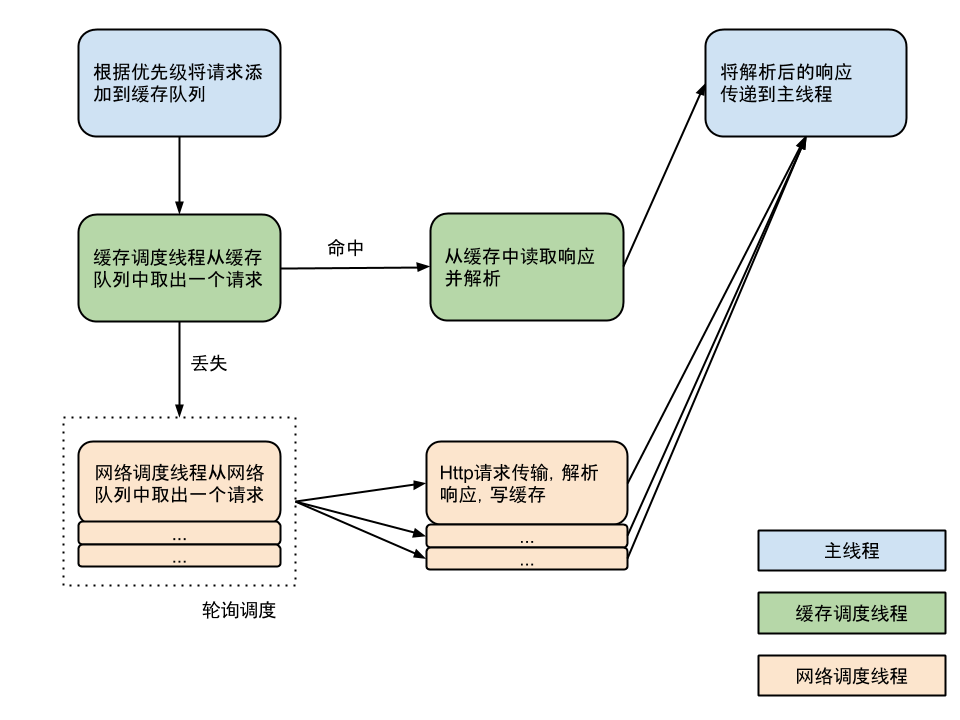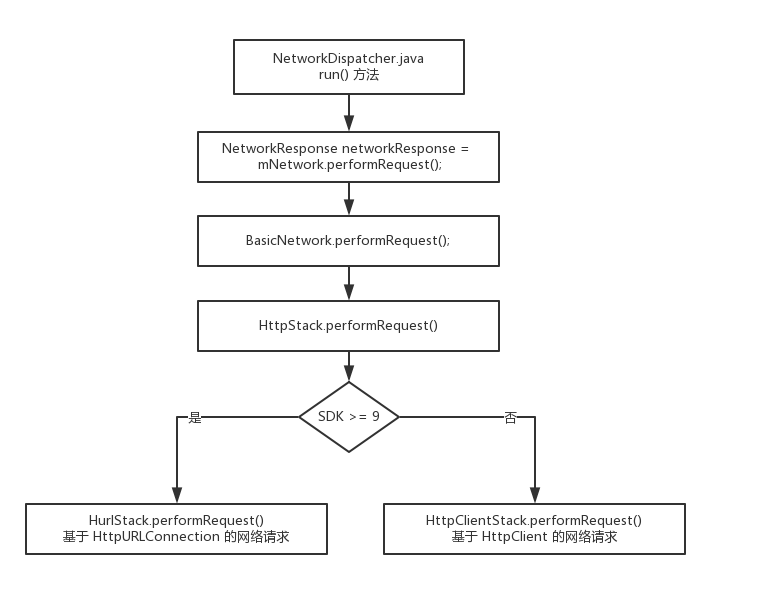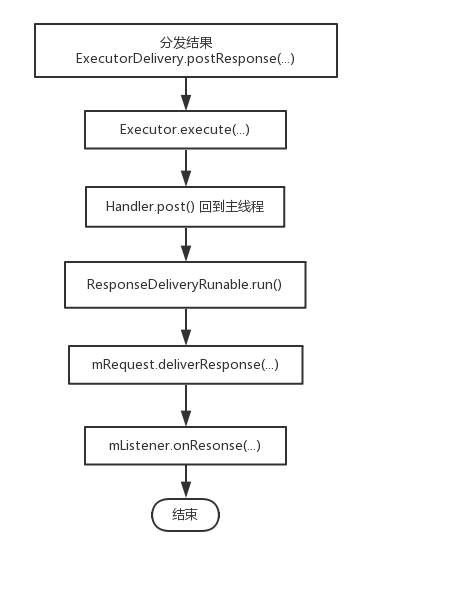Volley 中文翻译是齐射,这个名字也简要的说明了 Volley 的特点,适用于数据量小,频繁通信。
一、总体设计
1、总体设计图
2. 总体的流程图
(图片来自codeKK)
二、主要类
1、Request
抽象类,请求对象。直接子类: ImageRequest, JsonArrayRequest, JsonObjectRequest, JsonRequest, 以及StringRequest.
2、Network
接口,用于网络请求, 实现类是 BasicNetwork;
3、CacheDispatcher
一个线程,处理磁盘缓存请求;
4、NetworkDispatcher
一个线程,处理网络请求;
5、HttpStack
接口,根据给定的参数,执行一个网络请求,并返回请求结果;
实现类是基于 HttpURLConnection 的 HurlStack, 在 SDK >= 9 版本上使用;另外一个是基于 HttpClient 的HttpClientStack, 在 SDK < 9 版本以下使用;
6、ResponseDelivery
接口,用于分发结果,实现类是 ExecutorDelivery;
7、Cache
接口, 缓存请求结果,实现类是磁盘缓存的 DiskBasedCache.
三、具体类分析
1、Request
Request 是一个抽象类,子类需要重写主要的两个方法:
分发结果给 listener
abstract protected void deliverResponse(T response);
将网络请求返回的数据转化成请求的数据类型,在工作线程中被调用
abstract protected Response<T> parseNetworkResponse(NetworkResponse response);
2、Network
Network 是一个接口,它的实现类需要实现方法,执行一个特定的请求
public NetworkResponse performRequest(Request<?> request) throws VolleyError;
实现类 BasicNetwork 中的该方法,在工作线程中被调用
@Override
public NetworkResponse performRequest(Request<?> request) throws VolleyError {
// 请求开始时间
long requestStart = SystemClock.elapsedRealtime();
while (true) {
HttpResponse httpResponse = null;
byte[] responseContents = null;
// 请求头部
Map<String, String> responseHeaders = Collections.emptyMap();
try {
// Gather headers.
Map<String, String> headers = new HashMap<String, String>();
addCacheHeaders(headers, request.getCacheEntry());
// 执行网络请求返回请求结果
httpResponse = mHttpStack.performRequest(request, headers);
StatusLine statusLine = httpResponse.getStatusLine();
int statusCode = statusLine.getStatusCode();
responseHeaders = convertHeaders(httpResponse.getAllHeaders());
// Handle cache validation.
if (statusCode == HttpStatus.SC_NOT_MODIFIED) {
Entry entry = request.getCacheEntry();
if (entry == null) {
return new NetworkResponse(HttpStatus.SC_NOT_MODIFIED, null,
responseHeaders, true,
SystemClock.elapsedRealtime() - requestStart);
}
// A HTTP 304 response does not have all header fields. We
// have to use the header fields from the cache entry plus
// the new ones from the response.
// http://www.w3.org/Protocols/rfc2616/rfc2616-sec10.html#sec10.3.5
entry.responseHeaders.putAll(responseHeaders);
return new NetworkResponse(HttpStatus.SC_NOT_MODIFIED, entry.data,
entry.responseHeaders, true,
SystemClock.elapsedRealtime() - requestStart);
}
// Handle moved resources
if (statusCode == HttpStatus.SC_MOVED_PERMANENTLY || statusCode == HttpStatus.SC_MOVED_TEMPORARILY) {
String newUrl = responseHeaders.get("Location");
request.setRedirectUrl(newUrl);
}
// Some responses such as 204s do not have content. We must check.
if (httpResponse.getEntity() != null) {
responseContents = entityToBytes(httpResponse.getEntity());
} else {
// Add 0 byte response as a way of honestly representing a
// no-content request.
responseContents = new byte[0];
}
// if the request is slow, log it.
long requestLifetime = SystemClock.elapsedRealtime() - requestStart;
logSlowRequests(requestLifetime, request, responseContents, statusLine);
if (statusCode < 200 || statusCode > 299) {
throw new IOException();
}
return new NetworkResponse(statusCode, responseContents, responseHeaders, false, SystemClock.elapsedRealtime() - requestStart);
}
...
}
}
3、CacheDispatcher
一个线程,通过它的 start() 方法启动
(1)主要的成员变量
/** The queue of requests coming in for triage.*/
// 缓存请求队列
private final BlockingQueue<Request<?>> mCacheQueue;
/** The queue of requests going out to the network. */
// 网络请求队列
private final BlockingQueue<Request<?>> mNetworkQueue;
/** The cache to read from. */
// 缓存类
private final Cache mCache;
/** For posting responses. */
// 分发结果类
private final ResponseDelivery mDelivery;主要步骤是,从缓存队列中取出一个请求,然后从缓存中取数据,判读数据是否需要更新、过时等信息,再者将数据转化成请求的数据格式,最后进行分发;
@Override
public void run() {
if (DEBUG) VolleyLog.v("start new dispatcher");
// 设置为后台线程
Process.setThreadPriority(Process.THREAD_PRIORITY_BACKGROUND);
// Make a blocking call to initialize the cache.
// 缓存的初始化
mCache.initialize(); // DiskBasedCache.initialize()
Request<?> request;
while (true) { // 死循环,会不断的从队列中取请求
// release previous request object to avoid leaking request object when mQueue is drained.
request = null;
try {
// Take a request from the queue.
// 1、从队列中取出一个请求
request = mCacheQueue.take();
} catch (InterruptedException e) {
// We may have been interrupted because it was time to quit.
if (mQuit) {
return;
}
continue;
}
try {
request.addMarker("cache-queue-take");
// If the request has been canceled, don't bother dispatching it.
// 请求是否被取消,如果取消了,跳过
if (request.isCanceled()) {
request.finish("cache-discard-canceled");
continue;
}
// Attempt to retrieve this item from cache.
// 2.从缓存中拿数据,如果是空的,则放到一个网络请求队列中,然后跳过
Cache.Entry entry = mCache.get(request.getCacheKey());
if (entry == null) {
request.addMarker("cache-miss");
// Cache miss; send off to the network dispatcher.
mNetworkQueue.put(request);
continue;
}
// If it is completely expired(过时), just send it to the network.
// 如果数据已经过时了,则放进网络请求队列中,再一次请求, 跳过
if (entry.isExpired()) {
request.addMarker("cache-hit-expired");
request.setCacheEntry(entry);
mNetworkQueue.put(request);
continue;
}
// We have a cache hit; parse its data for delivery back to the request.
// 3.将缓存中拿到的数据转化成请求的数据格式,例如 String, JSON 之类的。
request.addMarker("cache-hit");
Response<?> response = request.parseNetworkResponse(new NetworkResponse(entry.data, entry.responseHeaders));
request.addMarker("cache-hit-parsed");
// 4.如果缓存数据不需要刷新,直接分发结果;否则在分发结果的同时也放到网络请求中,再一次请求。
if (!entry.refreshNeeded()) {
// Completely unexpired cache hit. Just deliver the response.
mDelivery.postResponse(request, response);
} else {
// Soft-expired cache hit. We can deliver the cached response,
// but we need to also send the request to the network for
// refreshing.
request.addMarker("cache-hit-refresh-needed");
request.setCacheEntry(entry);
// Mark the response as intermediate.
response.intermediate = true;
// Post the intermediate response back to the user and have
// the delivery then forward the request along to the network.
final Request<?> finalRequest = request;
mDelivery.postResponse(request, response, new Runnable() {
@Override
public void run() {
try {
// 放入到网络请求队列中
mNetworkQueue.put(finalRequest);
} catch (InterruptedException e) {
// Not much we can do about this.
}
}
});
}
} catch (Exception e) {
VolleyLog.e(e, "Unhandled exception %s", e.toString());
}
}
}4、NetworkDispatcher
一个线程,通过它的 start() 方法启动。在 RequestQueue 中会启动四个默认的 NetworkDispatcher 用于网络请求;
(1) 主要成员变量
/** The queue of requests to service. */
// 请求队列
private final BlockingQueue<Request<?>> mQueue;
/** The network interface for processing requests. */
// 网络请求接口,用于网络请求
private final Network mNetwork;
/** The cache to write to. */
// 缓存类,用于存储请求回来的数据
private final Cache mCache;
/** For posting responses and errors. */
// 分发结果类
private final ResponseDelivery mDelivery;(2) 主要步骤
从请求队列中取出一个请求,然后进行网络请求并返回请求结果,将返回的数据转化成请求的数据格式类型,如果需要缓存则放到缓存中,最后是分发结果;
@Override
public void run() {
// 设置为后台线程
Process.setThreadPriority(Process.THREAD_PRIORITY_BACKGROUND);
Request<?> request;
while (true) {
// 开始时间
long startTimeMs = SystemClock.elapsedRealtime();
// release previous request object to avoid leaking request object when mQueue is drained.
request = null;
try {
// Take a request from the queue.
// 1、从请求队列取出请求
request = mQueue.take();
} catch (InterruptedException e) {
// We may have been interrupted because it was time to quit.
if (mQuit) {
return;
}
continue;
}
try {
request.addMarker("network-queue-take");
// If the request was cancelled already, do not perform the
// network request.
// 请求已经被取消
if (request.isCanceled()) {
request.finish("network-discard-cancelled");
continue;
}
addTrafficStatsTag(request);
// Perform the network request.
// 2、进行网络请求,并返回 (调用 BasicNetwork.perfomRequest(...))
NetworkResponse networkResponse = mNetwork.performRequest(request);
request.addMarker("network-http-complete");
// If the server returned 304 AND we delivered a response already,
// we're done -- don't deliver a second identical response.
if (networkResponse.notModified && request.hasHadResponseDelivered()) {
request.finish("not-modified");
continue;
}
// Parse the response here on the worker thread.
// 3、将网络请求的回来的数据,转化成请求的所需要的数据格式
Response<?> response = request.parseNetworkResponse(networkResponse);
request.addMarker("network-parse-complete");
// Write to cache if applicable.
// TODO: Only update cache metadata instead of entire record for 304s.
// 4、如果需要磁盘缓存,则放到磁盘缓存中
if (request.shouldCache() && response.cacheEntry != null) {
mCache.put(request.getCacheKey(), response.cacheEntry);
request.addMarker("network-cache-written");
}
// Post the response back.
request.markDelivered();
// 5、分发请求结果
mDelivery.postResponse(request, response);
} catch (VolleyError volleyError) {
volleyError.setNetworkTimeMs(SystemClock.elapsedRealtime() - startTimeMs);
parseAndDeliverNetworkError(request, volleyError);
} catch (Exception e) {
VolleyLog.e(e, "Unhandled exception %s", e.toString());
VolleyError volleyError = new VolleyError(e);
volleyError.setNetworkTimeMs(SystemClock.elapsedRealtime() - startTimeMs);
mDelivery.postError(request, volleyError);
}
}
}
5、HttpStack
一个接口,实现类需要实现执行一个 HTTP 请求
public HttpResponse performRequest(Request<?> request, Map<String, String> additionalHeaders)
throws IOException, AuthFailureError;
@Override
public HttpResponse performRequest(Request<?> request, Map<String, String> additionalHeaders) throws IOException, AuthFailureError {
String url = request.getUrl();
// 放置头文件
HashMap<String, String> map = new HashMap<String, String>();
map.putAll(request.getHeaders());
map.putAll(additionalHeaders);
if (mUrlRewriter != null) {
String rewritten = mUrlRewriter.rewriteUrl(url);
if (rewritten == null) {
throw new IOException("URL blocked by rewriter: " + url);
}
url = rewritten;
}
URL parsedUrl = new URL(url);
// 设置链接
HttpURLConnection connection = openConnection(parsedUrl, request);
for (String headerName : map.keySet()) {
connection.addRequestProperty(headerName, map.get(headerName));
}
// 设置连接参数
setConnectionParametersForRequest(connection, request);
// 设定 HTTP 协议版本
// Initialize HttpResponse with data from the HttpURLConnection.
ProtocolVersion protocolVersion = new ProtocolVersion("HTTP", 1, 1);
int responseCode = connection.getResponseCode();
if (responseCode == -1) {
// -1 is returned by getResponseCode() if the response code could not be retrieved.
// Signal to the caller that something was wrong with the connection.
throw new IOException("Could not retrieve response code from HttpUrlConnection.");
}
StatusLine responseStatus = new BasicStatusLine(protocolVersion,
connection.getResponseCode(), connection.getResponseMessage());
BasicHttpResponse response = new BasicHttpResponse(responseStatus);
if (hasResponseBody(request.getMethod(), responseStatus.getStatusCode())) {
// 将返回的数据设置到 response
response.setEntity(entityFromConnection(connection));
}
for (Entry<String, List<String>> header : connection.getHeaderFields().entrySet()) {
if (header.getKey() != null) {
Header h = new BasicHeader(header.getKey(), header.getValue().get(0));
response.addHeader(h);
}
}
return response;
}
/**
* Initializes an {@link HttpEntity} from the given {@link HttpURLConnection}.
* @param connection
* @return an HttpEntity populated with data from <code>connection</code>.
*/
private static HttpEntity entityFromConnection(HttpURLConnection connection) {
BasicHttpEntity entity = new BasicHttpEntity();
InputStream inputStream;
try {
// 获取数据流
inputStream = connection.getInputStream();
} catch (IOException ioe) {
inputStream = connection.getErrorStream();
}
entity.setContent(inputStream);
entity.setContentLength(connection.getContentLength());
entity.setContentEncoding(connection.getContentEncoding());
entity.setContentType(connection.getContentType());
return entity;
}实现类 HttpClientStack, 基于 HttpClient
@Override
public HttpResponse performRequest(Request<?> request, Map<String, String> additionalHeaders)
throws IOException, AuthFailureError {
// 创建一个 httpRequest 对象
HttpUriRequest httpRequest = createHttpRequest(request, additionalHeaders);
// 添加文件头
addHeaders(httpRequest, additionalHeaders);
addHeaders(httpRequest, request.getHeaders());
onPrepareRequest(httpRequest); // 空方法
// 参数
HttpParams httpParams = httpRequest.getParams();
int timeoutMs = request.getTimeoutMs();
// TODO: Reevaluate this connection timeout based on more wide-scale
// data collection and possibly different for wifi vs. 3G.
// 设置连接超时时间
HttpConnectionParams.setConnectionTimeout(httpParams, 5000);
HttpConnectionParams.setSoTimeout(httpParams, timeoutMs);
// 执行 HTTP 请求,并且返回
return mClient.execute(httpRequest);
}
6、ResponseDelivery
接口,实现类是 ExecutorDelivery, 根据传进来 Handler 所在线程内分发结果
在调用 Volley.newRequestQueue(...) 的时候,会生成一个新的 RequestQueue 对象,同时生成一个传入主线程 Handler 的
ExecutorDelivery;
/**
* Creates the worker pool. Processing will not begin until {@link #start()} is called.
*
* @param cache A Cache to use for persisting responses to disk
* @param network A Network interface for performing HTTP requests
* @param threadPoolSize Number of network dispatcher threads to create
*/
public RequestQueue(Cache cache, Network network, int threadPoolSize) {
// ExecutorDelivery 负责分发结果, 传入一个主线程的 Handler 进去,是为了在主线程中分发结果
this(cache, network, threadPoolSize, new ExecutorDelivery(new Handler(Looper.getMainLooper())));
}ExecutorDelivery 类
/**
* Delivers responses and errors.
*/
public class ExecutorDelivery implements ResponseDelivery {
/** Used for posting responses, typically to the main thread. */
// 用于 post 网络请求结果回调主线程
private final Executor mResponsePoster;
/**
* Creates a new response delivery interface.
* @param handler {@link Handler} to post responses on
*/
public ExecutorDelivery(final Handler handler) {
// Make an Executor that just wraps the handler.
// 执行器用来包裹 handler
mResponsePoster = new Executor() {
@Override
public void execute(Runnable command) {
handler.post(command);
}
};
}
/**
* Creates a new response delivery interface, mockable version
* for testing.
* @param executor For running delivery tasks
*/
public ExecutorDelivery(Executor executor) {
mResponsePoster = executor;
}
// 网络请求 NetworkDispatcher 的 run() 方法中,会调用 postResponse(...) 方法
@Override
public void postResponse(Request<?> request, Response<?> response) {
postResponse(request, response, null);
}
@Override
public void postResponse(Request<?> request, Response<?> response, Runnable runnable) {
request.markDelivered();
request.addMarker("post-response");
mResponsePoster.execute(new ResponseDeliveryRunnable(request, response, runnable));
}
@Override
public void postError(Request<?> request, VolleyError error) {
request.addMarker("post-error");
Response<?> response = Response.error(error);
mResponsePoster.execute(new ResponseDeliveryRunnable(request, response, null));
}
/**
* A Runnable used for delivering network responses to a listener on the
* main thread.
* 用于分发网络请求结果到主线程的 listener
*/
@SuppressWarnings("rawtypes")
private class ResponseDeliveryRunnable implements Runnable {
private final Request mRequest;
private final Response mResponse;
private final Runnable mRunnable;
public ResponseDeliveryRunnable(Request request, Response response, Runnable runnable) {
mRequest = request;
mResponse = response;
mRunnable = runnable;
}
@SuppressWarnings("unchecked")
@Override
public void run() {
// If this request has canceled, finish it and don't deliver.
if (mRequest.isCanceled()) {
mRequest.finish("canceled-at-delivery");
return;
}
// Deliver a normal response or error, depending.
// 分发结果,会调用 Request 具体实现类中的 deliverResponse(...) 方法
if (mResponse.isSuccess()) {
mRequest.deliverResponse(mResponse.result);
} else {
mRequest.deliverError(mResponse.error);
}
// If this is an intermediate response, add a marker, otherwise we're done
// and the request can be finished.
if (mResponse.intermediate) {
mRequest.addMarker("intermediate-response");
} else {
mRequest.finish("done");
}
// If we have been provided a post-delivery runnable, run it.
if (mRunnable != null) {
mRunnable.run();
}
}
}
}将分发结果传递给 listener
@Override
protected void deliverResponse(String response) {
if (mListener != null) {
mListener.onResponse(response);
}
}网络请求结果分发流程图
说明:
(1)、NetworkDispatcher 中将网络请求的结果调用方法 ReponseDelivery.postResponse(...) 方法进行分发,这是在 workerThread中, ResponseDelivery 只是接口,最终还是会调用实现类 ExecutorDelivery.postResponse(...) 方法;
(2)、ExecutroDelivery.postResonse(...) 方法用 抱箍 handler 的 Executor 将 ResponseDeliveryRunnable 任务 post 回到主线程执行;
(3)、然后将网络请求结果传递给 listener;
7、Cache
接口,实现类是 DiskBasedCache, 磁盘缓存,默认是大小时 5M
8、RequestQueue
核心类
主要成员变量:
自动生成请求序列号
mSequenceGenerator = new AtomicInteger()
等待 Set
mWaitingRequests = new HashMap<String, Queue<Request<?>>>();
当前缓存的 Set
mCurrentRequests = new HashSet<Request<?>>();
缓存队列
PriorityBlockingQueue<Request<?>> mCacheQueue;
网络请求队列
PriorityBlockingQueue<Request<?>> mNetworkQueue;
网络
Network mNetwork;
分发结果
ResponseDelivery mDelivery;
网络线程
NetworkDispatcher[] mDispatchers;
磁盘缓存线程
CacheDispatcher mCacheDispatcher;
(1)、生成一个 RequestQueue 对象时,传入一个主线程的 Handler, 用于分发结果;
/**
* Creates the worker pool. Processing will not begin until {@link #start()} is called.
*
* @param cache A Cache to use for persisting responses to disk
* @param network A Network interface for performing HTTP requests
* @param threadPoolSize Number of network dispatcher threads to create
*/
public RequestQueue(Cache cache, Network network, int threadPoolSize) {
// ExecutorDelivery 负责分发结果, 传入一个主线程的 Handler 进去,是为了在主线程中分发结果
this(cache, network, threadPoolSize, new ExecutorDelivery(new Handler(Looper.getMainLooper())));
}(2)、添加一个请求
/**
* Adds a Request to the dispatch queue.
* @param request The request to service
* @return The passed-in request
* 添加一个请求
*/
public <T> Request<T> add(Request<T> request) {
// Tag the request as belonging to this queue and add it to the set of current requests.
request.setRequestQueue(this);
synchronized (mCurrentRequests) {
// 添加到当前缓存 set 中
mCurrentRequests.add(request);
}
// Process requests in the order they are added.
// 设置 request 的序列号
request.setSequence(getSequenceNumber());
request.addMarker("add-to-queue");
// If the request is uncacheable, skip the cache queue and go straight to the network.
// 是否需要缓存,默认是 true; 放入到网络请求队列中,并返回
if (!request.shouldCache()) {
mNetworkQueue.add(request);
return request;
}
// Insert request into stage if there's already a request with the same cache key in flight.
synchronized (mWaitingRequests) {
String cacheKey = request.getCacheKey();
// 如果等待 Map 中已经有了 cacheKey
if (mWaitingRequests.containsKey(cacheKey)) {
// There is already a request in flight. Queue up.
Queue<Request<?>> stagedRequests = mWaitingRequests.get(cacheKey);
if (stagedRequests == null) {
stagedRequests = new LinkedList<Request<?>>();
}
stagedRequests.add(request);
mWaitingRequests.put(cacheKey, stagedRequests);
if (VolleyLog.DEBUG) {
VolleyLog.v("Request for cacheKey=%s is in flight, putting on hold.", cacheKey);
}
} else {
// Insert 'null' queue for this cacheKey, indicating there is now a request in flight.
mWaitingRequests.put(cacheKey, null);
// 放入到缓存队列中
mCacheQueue.add(request);
}
return request;
}
}(3)、调用 RequestQueue 的 start() 方法,会启动一个磁盘缓存线程和四个网络请求线程
/**
* Starts the dispatchers in this queue.
* 核心的开始
*/
public void start() {
stop(); // Make sure any currently running dispatchers are stopped.
// Create the cache dispatcher and start it.
// 创建磁盘缓存 dispatcher, 并启动
mCacheDispatcher = new CacheDispatcher(mCacheQueue, mNetworkQueue, mCache, mDelivery);
mCacheDispatcher.start(); // 会调用 CacheDispatcher.run() 方法
// Create network dispatchers (and corresponding threads) up to the pool size.
// 启动网络 dispatchers
for (int i = 0; i < mDispatchers.length; i++) { // 默认为四个
NetworkDispatcher networkDispatcher = new NetworkDispatcher(mNetworkQueue, mNetwork, mCache, mDelivery);
mDispatchers[i] = networkDispatcher;
networkDispatcher.start(); // 会调用 NetworkDispatcher.run() 方法
}
}9、Volley
对外提供 API, 并且启动请求队列 RequestQueue
/** Default on-disk cache directory. */
// 默认缓存目录
private static final String DEFAULT_CACHE_DIR = "volley";
/**
* Creates a default instance of the worker pool and calls {@link RequestQueue#start()} on it.
* You may set a maximum size of the disk cache in bytes.
*
* @param context A {@link Context} to use for creating the cache dir.
* @param stack An {@link HttpStack} to use for the network, or null for default.
* @param maxDiskCacheBytes the maximum size of the disk cache, in bytes. Use -1 for default size.
* @return A started {@link RequestQueue} instance.
*/
public static RequestQueue newRequestQueue(Context context, HttpStack stack, int maxDiskCacheBytes) {
// 创建缓存文件
File cacheDir = new File(context.getCacheDir(), DEFAULT_CACHE_DIR);
String userAgent = "volley/0";
try {
String packageName = context.getPackageName();
PackageInfo info = context.getPackageManager().getPackageInfo(packageName, 0);
userAgent = packageName + "/" + info.versionCode;
} catch (NameNotFoundException e) {
}
if (stack == null) {
// 如果版本大于等于 9 使用 HurlStack, 否则使用 HttpClientStack.
// HurlStack 是用 HttpURLConnection, HttpClientStack 用的是 HttpClient
if (Build.VERSION.SDK_INT >= 9) {
stack = new HurlStack();
} else {
// Prior to Gingerbread, HttpUrlConnection was unreliable.
// See: http://android-developers.blogspot.com/2011/09/androids-http-clients.html
stack = new HttpClientStack(AndroidHttpClient.newInstance(userAgent));
}
}
// 网络请求, 实现类是 BasicNetwork
Network network = new BasicNetwork(stack);
RequestQueue queue; // RequestQueue 是核心
if (maxDiskCacheBytes <= -1){
// No maximum size specified
// 没有指定磁盘缓存大小时, 使用默认 5M
queue = new RequestQueue(new DiskBasedCache(cacheDir), network);
}else{
// Disk cache size specified
// 指定磁盘缓存大小时
queue = new RequestQueue(new DiskBasedCache(cacheDir, maxDiskCacheBytes), network);
}
// 请求队列,队列默认启动四个网络线程请求
queue.start();
return queue;
}
三、使用例子
已 StringRequest 为例
// Instantiate the RequestQueue.
// 实例化 RequestQueue,里面会启动请求队列
RequestQueue queue = Volley.newRequestQueue(this);
String url ="http://www.baidu.com";
// Request a string response from the provided URL.
// 生成一个新的 Request 对象
StringRequest stringRequest = new StringRequest(Request.Method.GET, url, new Response.Listener<String>() {
@Override
public void onResponse(String response) {
// 返回结果
Log.i("volley", "response " + response);
}
}, new Response.ErrorListener() {
@Override
public void onErrorResponse(VolleyError error) {
// 返回错误
}
});
// Add the request to the RequestQueue.
// 添加到请求队列
queue.add(stringRequest);
}
分析完成。




























 590
590

 被折叠的 条评论
为什么被折叠?
被折叠的 条评论
为什么被折叠?








